Understanding Autism and Down Syndrome: Key Differences and Similarities
Autism Spectrum Disorder (ASD) and Down syndrome are two conditions that affect development but stem from different causes and present unique characteristics. This article delves into their definitions, causes, symptoms, diagnosis, developmental traits, co-occurrence, support strategies, and evolving research to provide a comprehensive comparison.
Defining Autism Spectrum Disorder and Down Syndrome
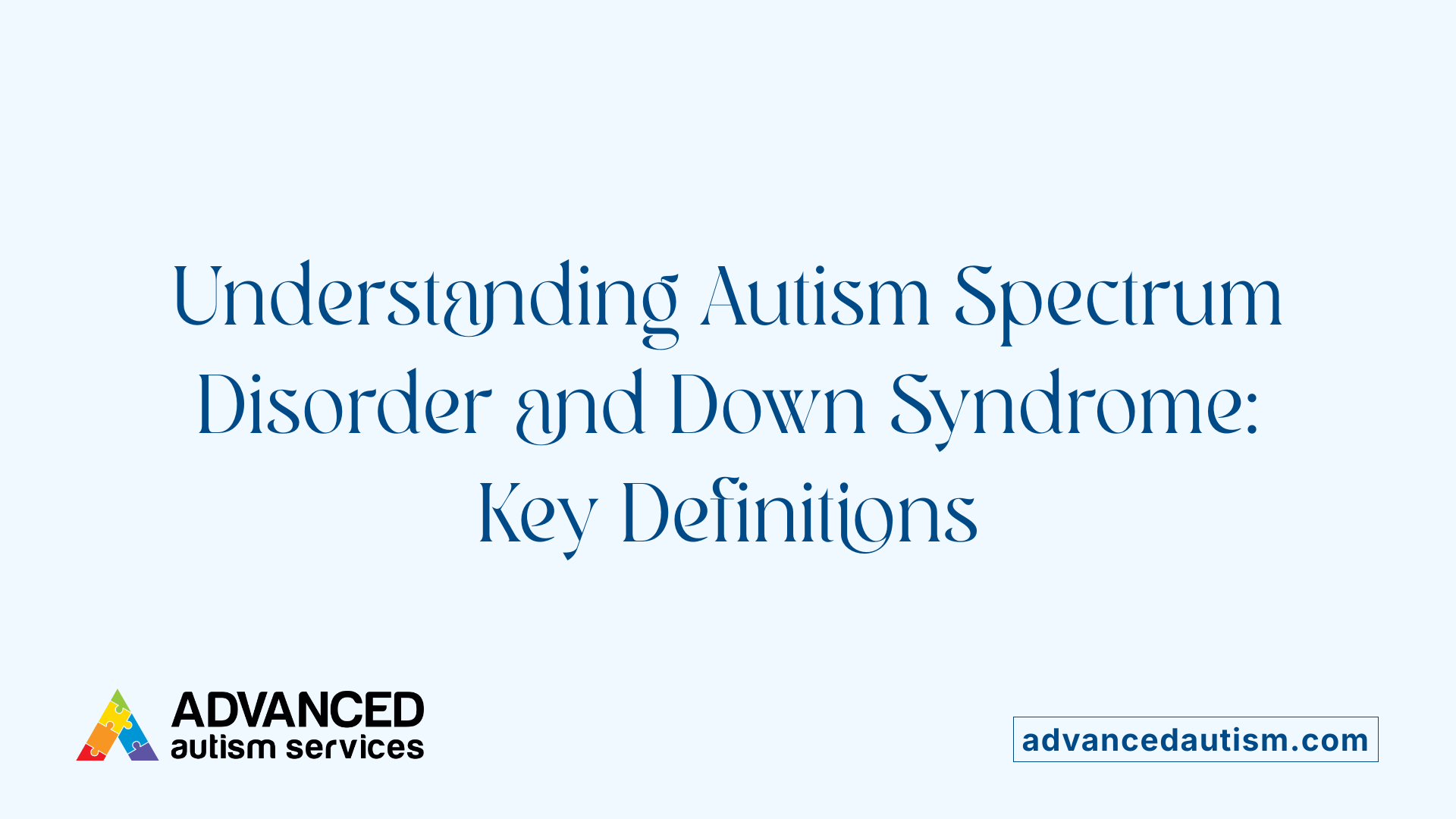
What is Autism Spectrum Disorder?
Autism Spectrum Disorder (ASD) is a neurodevelopmental condition that primarily affects how individuals communicate, behave, and interact socially. It is characterized by persistent challenges in understanding social cues, difficulties in forming and maintaining relationships, and the presence of restrictive and repetitive behaviors. People with ASD may exhibit behaviors such as limited eye contact, unusual responses to sensory stimuli, repetitive movements, and strong preferences for routines. The severity and specific symptoms of autism can vary widely among individuals, making it a spectrum.
Many children with ASD also experience sensory sensitivities, reacting strongly to sounds, lights, textures, or smells. These sensory sensitivities can cause discomfort or distress and influence behaviors and interactions. Early signs of autism often appear within the first two years of life, including delays in language, social engagement, and unusual play patterns. The diagnosis typically involves comprehensive evaluations by specialists using tools like the ADOS, CARS, or M-CHAT.
While autism impacts social and behavioral aspects, it does not have distinctive physical features. Its causes are complex, involving a combination of genetic and environmental factors that influence brain development. Even though the exact cause remains unclear, ongoing research continues to improve understanding and management strategies focusing on therapies such as behavioral interventions, speech therapy, and sometimes medications for associated symptoms.
What is Down Syndrome?
Down syndrome is a chromosomal disorder caused by the presence of an extra full or partial copy of chromosome 21, known as trisomy 21. This genetic variation results in a range of physical and intellectual traits that define the condition. Common physical features include a flat facial profile, upward-slanting eyes, a short neck, low muscle tone (hypotonia), and characteristic hand and foot features. These physical traits are often noticeable at birth or shortly afterward.
Children with Down syndrome typically experience mild to moderate intellectual disability, which affects learning, problem-solving, and language development. Speech and language delays are common, with many children obtaining their first words later than their peers. Additionally, there are increased health risks associated with Down syndrome, such as congenital heart defects, hearing and vision problems, thyroid issues, sleep apnea, gastrointestinal anomalies, and increased susceptibility to infections.
Down syndrome’s cause is specific and well-understood, linking it to an extra chromosome resulting from nondisjunction during cell division. The prevalence is approximately 1 in 700 births, making it one of the most common chromosomal disorders.
Comparing Autism Spectrum Disorder and Down Syndrome
| Aspect | Autism Spectrum Disorder (ASD) | Down Syndrome |
|---|---|---|
| Cause | Genetic and environmental factors affecting brain development | Extra copy of chromosome 21 (trisomy 21) |
| Physical features | No distinctive physical signs | Flat facial profile, upward-slanting eyes, low muscle tone |
| Main challenges | Social interaction, communication, sensory sensitivities, repetitive behaviors | Intellectual disability, speech delays, medical issues like heart defects |
| Behavioral traits | Repetitive behaviors, sensory sensitivities, social difficulties | Hypotonia, delayed motor skills, general developmental delays |
| Age of diagnosis | Usually between 15 months and early childhood | Usually at birth or prenatal via genetic testing |
Overlapping and Distinct Features
Both conditions can impact communication and social skills and involve developmental delays. Some children with Down syndrome may exhibit behaviors similar to ASD, such as social withdrawal or repetitive actions. Conversely, some individuals with autism may also have physical characteristics resembling Down syndrome, although these are less common.
It is important to recognize that while ASD and Down syndrome can coexist—referred to as dual diagnosis—they also appear independently. Accurate diagnosis involves careful observation, developmental assessments, and genetic testing when appropriate. Understanding the differences helps tailor interventions, which may include behavioral therapies, speech and occupational therapy, and medical management.
This awareness ensures that each individual receives appropriate support aimed at improving their development, behavior, and quality of life.
Causes and Genetic Factors Behind Each Condition
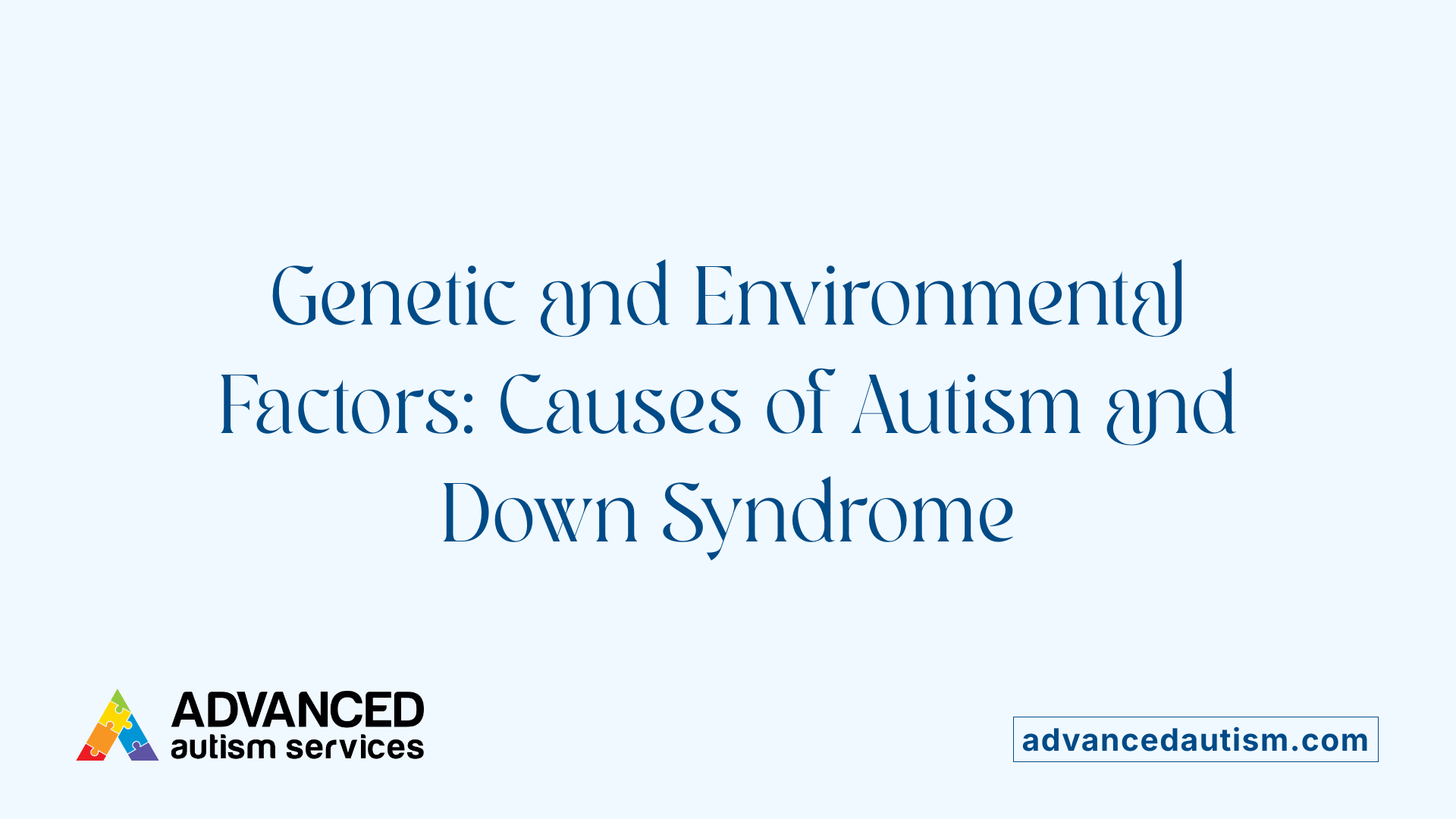
What are the causes and genetic factors associated with Autism and Down Syndrome?
Autism Spectrum Disorder (ASD) and Down syndrome have distinct origins rooted in their genetic and environmental causes. Understanding these underlying factors helps in early diagnosis, intervention, and support.
Autism involves a highly complex genetic landscape. It is considered a neurodevelopmental disorder influenced by multiple gene variations, mutations, and epigenetic factors. Research suggests that inheritable gene differences, known as genetic variants, contribute significantly to autism risk. These include de novo mutations, which are new genetic changes not inherited from parents, and copy number variations (CNVs) — duplications or deletions of chromosome segments that affect neural development.
Many genes associated with synapse formation, neural communication, and chromatin (DNA packaging) regulation are involved. Heritability estimates for autism range from 60-90%, meaning genetic factors play a substantial role, although environmental influences also contribute.
Environmental factors can increase the likelihood of developing ASD and include parental age, prenatal exposures, maternal health conditions, and birth complications. For example, advanced paternal age has been linked to higher autism risk, possibly due to increased mutations in sperm cells. Exposure to pollutants during pregnancy or maternal illnesses can also influence neurodevelopment through epigenetic mechanisms, which modify gene expression without changing DNA sequence.
Down syndrome, on the other hand, results primarily from a chromosomal anomaly known as trisomy 21. This occurs when there is an extra copy of chromosome 21 in the cells. The most common cause is nondisjunction, a failure of chromosomes to separate properly during meiosis, leading to a full extra chromosome in the embryo.
In some cases, translocation can cause Down syndrome. This occurs when a piece of chromosome 21 attaches to another chromosome, and it can be inherited from a parent who carries a balanced translocation — a form of genetic rearrangement that doesn't affect the parent but can cause Down syndrome in offspring.
Risk factors for Down syndrome include advanced maternal age; as women age, the likelihood of nondisjunction increases. This is why prenatal testing often suggests higher prevalence among older pregnancies.
Overall, while Down syndrome has a clear chromosomal cause, autism's origins are more diverse, involving multiple genetic mutations and environmental factors that influence brain development.
| Condition | Genetic Cause | Typical Risk Factors | Mode of Inheritance |
|---|---|---|---|
| Autism Spectrum Disorder | Gene variations, mutations, epigenetics | Parental age, prenatal exposures, maternal health, birth complications | Multifactorial, involving many genes and environment |
| Down syndrome | Nondisjunction leading to trisomy 21 | Advanced maternal age, translocation inheritance | Usually sporadic, translocation can be inherited |
Understanding these causes provides insight into the biological complexity of each condition and highlights the importance of genetic counseling and early screening.
Symptoms and Physical Characteristics
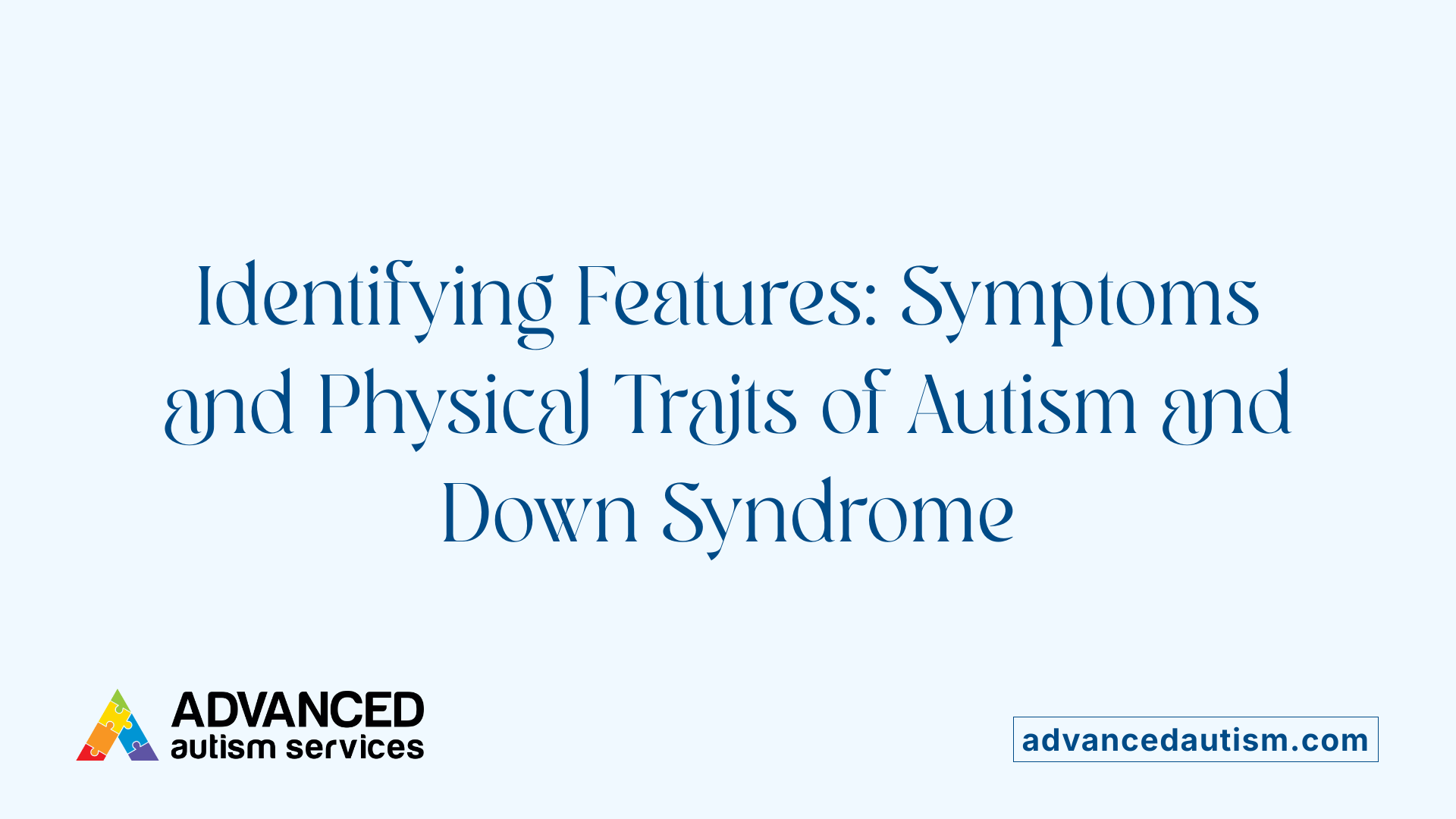
What are the typical symptoms and physical characteristics of Autism and Down Syndrome?
Autism Spectrum Disorder (ASD) presents primarily with challenges in social communication and repetitive behaviors. Children with autism often struggle with making eye contact, responding to their names, and interpreting social cues. They might display repetitive movements, such as hand-flapping or rocking, and have strong sensory sensitivities, reacting intensely to loud noises, certain textures, or smells.
In contrast, Down syndrome is identified by distinctive physical features and developmental delays. Typical physical traits include almond-shaped eyes with skin covering the inner corners, a flat facial profile, a short neck, small head, and a protruding tongue. Children with Down syndrome usually have poor muscle tone, which can lead to delayed motor skills and slower physical development. They may also have a single crease across the palm, short stature, and additional medical issues like congenital heart defects.
When exploring overlaps, especially in individuals with both conditions, behaviors such as social withdrawal, increased sensory sensitivities, and repetitive movements become more prominent. These dual diagnoses can complicate clinical assessments, but understanding the common traits helps in early detection and support.
Below is a table summarizing the physical and behavioral features:
| Condition | Common Physical Features | Behavioral Traits | Additional Notes |
|---|---|---|---|
| Autism | - No distinctive physical traits | - Social communication difficulties | - Variably severe repetitive behaviors |
| Down syndrome | - Flat facial profile | - Developmental delays | - Characteristic physical features |
| Both conditions | - Overlapping behaviors | - Sensory sensitivities | - Often require tailored intervention strategies |
Recognizing these symptoms early can significantly improve management and support for individuals affected by either or both conditions. Medical assessment and behavioral evaluations by specialists are crucial for accurate diagnosis and effective intervention planning.
Diagnosis Procedures for Each Condition
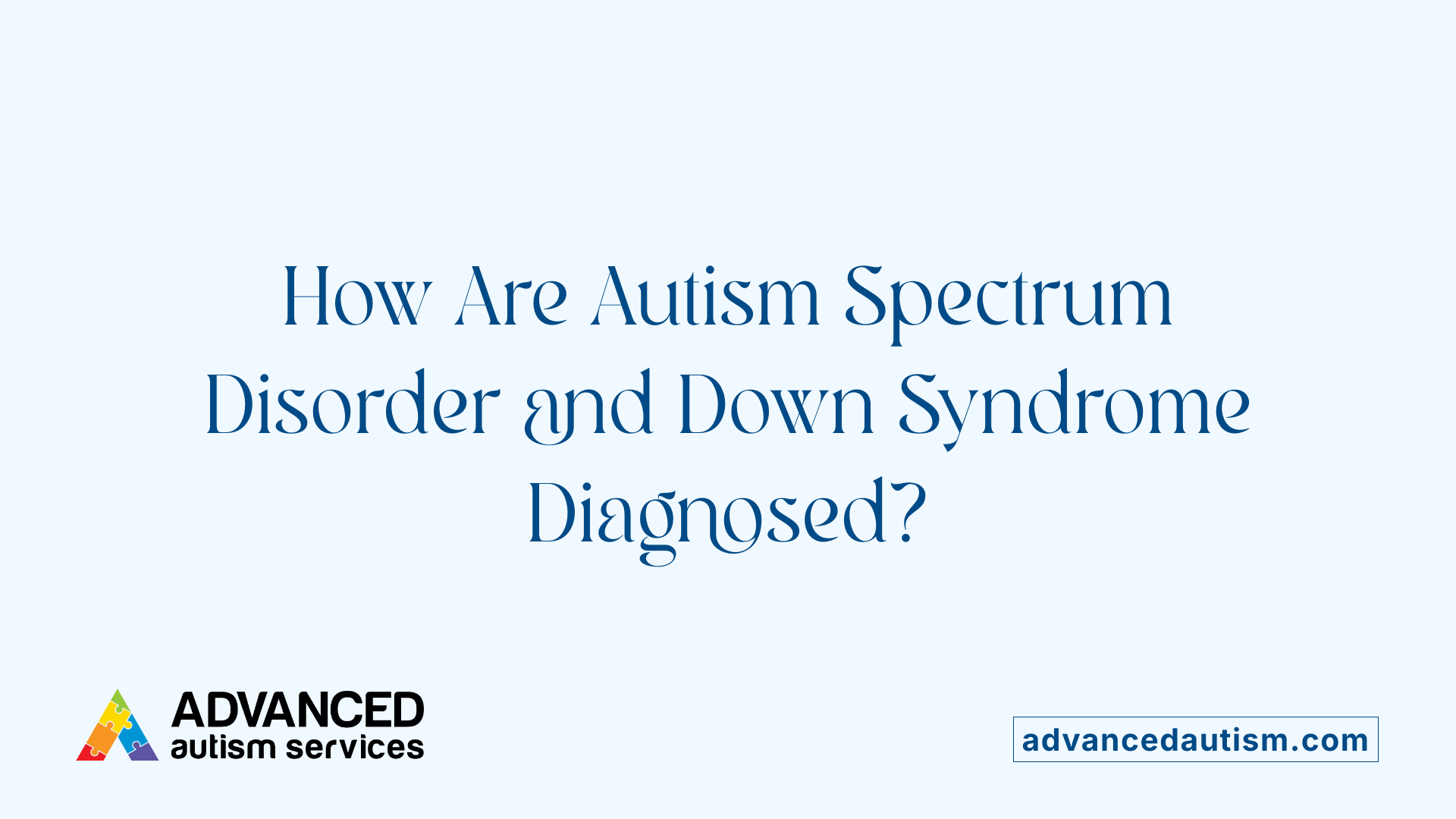
How are Autism Spectrum Disorder and Down Syndrome diagnosed?
Diagnosing Down syndrome involves a straightforward genetic test. The most common method is karyotyping, a chromosomal analysis that examines the shape and number of chromosomes in a sample of blood or tissue. This test can confirm the presence of an extra copy of chromosome 21, which definitively diagnose Down syndrome.
In contrast, diagnosing autism spectrum disorder (ASD) is more complex. It primarily relies on behavioral assessments conducted by specialized healthcare professionals, including developmental pediatricians, neurologists, psychologists, or psychiatrists. The process involves gathering detailed information about the child's developmental history, social interactions, communication skills, and behavior patterns.
Several standardized tools assist in evaluation:
| Diagnostic Tool | Description | Purpose |
|---|---|---|
| ADOS (Autism Diagnostic Observation Schedule) | A structured observational assessment | Used to identify behaviors typical of ASD |
| ADI-R (Autism Diagnostic Interview-Revised) | A comprehensive interview with parents or caregivers | Assists in diagnosing ASD based on developmental history |
| M-CHAT (Modified Checklist for Autism in Toddlers) | A screening questionnaire for early detection | Flags children at risk for ASD |
| SCQ (Social Communication Questionnaire) | A screening tool for school-aged children | Helps identify children who may need further assessment |
Initial screening tools like M-CHAT or SCQ are valuable for early identification, but they do not provide a definitive diagnosis. A formal diagnosis of ASD requires a detailed clinical evaluation, including direct observation, standardized testing, and reports from parents or caregivers.
It is also important to rule out other conditions that may cause similar symptoms, such as intellectual disabilities or other developmental disorders. Sometimes, children with Down syndrome also show behaviors resembling autism, which can complicate diagnosis. Therefore, a comprehensive approach that considers all aspects of development and health status is essential.
In summary, while Down syndrome diagnosis hinges on chromosomal analysis, ASD diagnosis involves behavioral assessments and standardized tools. Early and accurate diagnosis is vital, as it opens doors to targeted interventions that can improve developmental and social outcomes for children with these conditions.
Developmental, Behavioral Traits and Complications
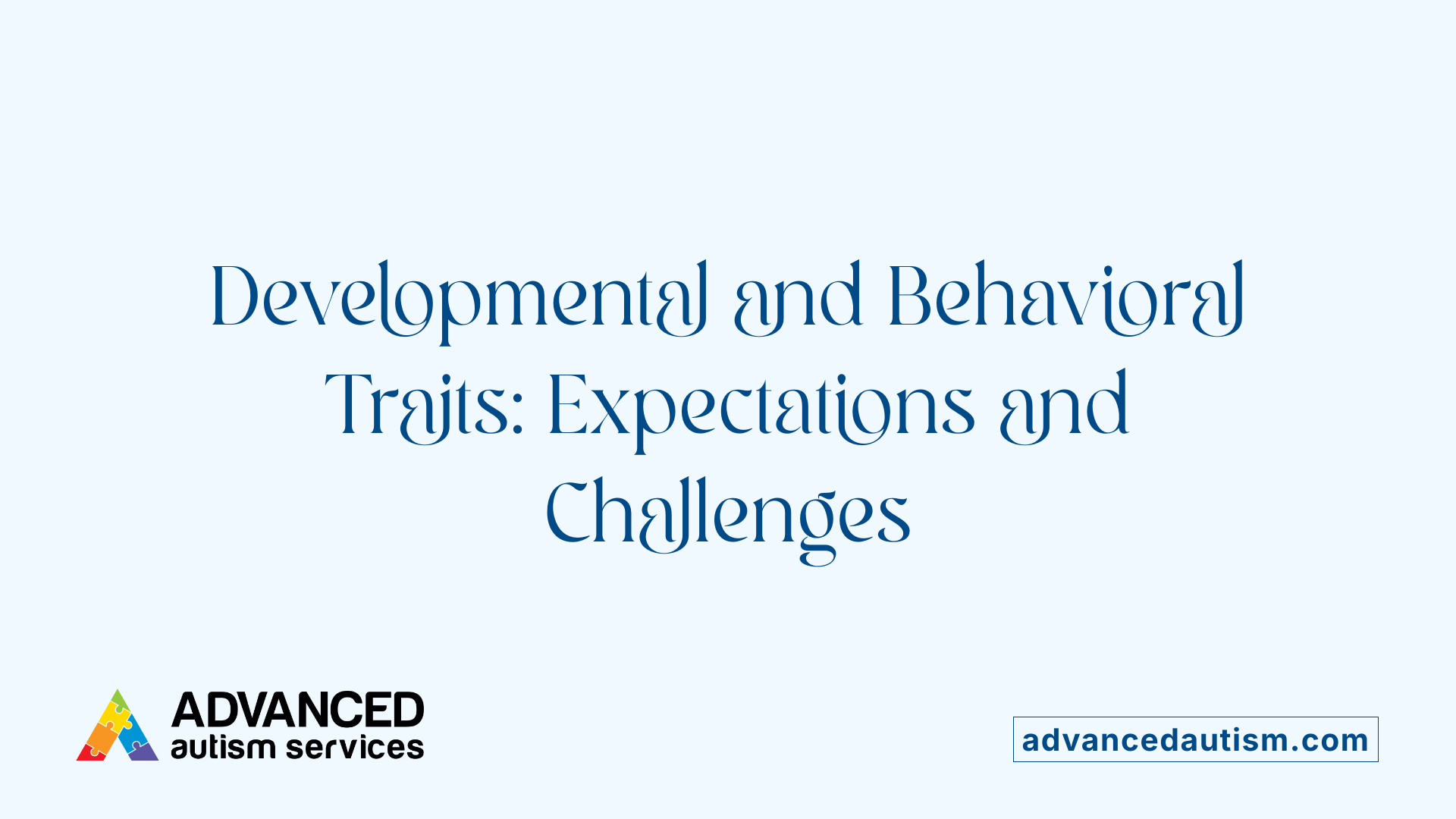
What developmental and behavioral traits are associated with Autism and Down Syndrome?
Children with Autism Spectrum Disorder (ASD) and Down syndrome (DS) often display overlapping developmental and behavioral features, though each condition also has unique aspects. Recognizing these traits early can significantly influence intervention strategies.
In children with DS and ASD, early signs include repetitive behaviors such as hand-flapping, rocking, or fixating on objects like lights or specific foods. They may also show social withdrawal, such as avoiding eye contact, not responding to their name, and limited use of gestures. Developmental regression, particularly between ages three and seven, is another hallmark. During this period, some children lose previously acquired language or social skills.
Sensory sensitivities are common, with children exhibiting hypersensitivity to sounds, textures, and smells. These sensitivities can lead to resistance to physical contact, grooming, or changes in routine, which escalate behavioral challenges.
Behavioral issues can involve irritability, tantrums, meltdowns, hyperactivity, and self-injurious actions. Sleep disturbances and difficulties with routine changes are also prominent. Social interactions may be marked by limited interest or difficulties in understanding social cues, although children with DS might be more socially interested than their peers with autism alone.
Children with DS-ASD frequently have additional medical problems compared to children with DS alone. These include congenital heart defects, gastrointestinal issues, seizures, ophthalmologic concerns, and neurological challenges such as hypotonia or delayed motor skills.
The neurodevelopmental differences are also evident in brain structure. MRI studies show variations in the cerebellum and corpus callosum among children with DS-ASD versus those with DS only.
Early assessment using a comprehensive set of diagnostic tools—such as the Autism Diagnostic Observation Schedule (ADOS), Autism Diagnostic Interview-Revised (ADI-R), and screening instruments like the M-CHAT—helps in detecting autism symptoms within the DS population. An accurate diagnosis enables targeted intervention, combining behavioral therapies, pharmacological treatments, and medical management to address the complexblend of developmental, behavioral, and medical needs.
Children with DS and ASD may show early signs like repetitive behaviors, social withdrawal, and developmental regression.
Early signs include,
- Repetitive motor actions, fascination with lights, objects
- Extreme food refusal
- Receptive language difficulties
- Obsessive staring
- Developmental regression in language and social skills
Medical issues tend to be more prevalent and severe in children with dual diagnoses,
- Cardiac defects
- Seizures
- Gastrointestinal problems
- Neurological concerns like hypotonia
- Ophthalmologic conditions
Monitoring and management of these medical conditions are integral to improving overall developmental outcomes.
Co-occurrence and Clinical Interaction of Autism and Down Syndrome
Is it common for individuals with Down syndrome also to have autism spectrum disorder?
Recent research shows that approximately 16% to 18% of people with Down syndrome (DS) also have ASD. This co-occurrence is significant because it means that nearly one in five children with DS may face additional developmental challenges linked to autism. Data from various studies indicate that the prevalence of ASD in individuals with Down syndrome varies widely, with some reports suggesting rates up to 39%. Recognizing this overlap is important for providing appropriate support and intervention.
How do autism and Down syndrome interact in affected individuals?
Children with both conditions often display a combination of features from each disorder. They tend to have more severe social and behavioral challenges, such as difficulties in social communication, increased repetitive behaviors, and sensory sensitivities. Medical concerns are also more complex, with higher instances of gastrointestinal issues, heart problems, seizures, and sleep disturbances.
Compared to children with DS alone, those with dual diagnosis may experience developmental regression, especially in language and social skills, and often show more noticeable behavioral issues, including tantrums and self-injury. Their social interest might be higher than typical for children with autism alone, yet social interactions remain challenging.
Why are recognition and diagnosis of dual diagnosis challenging?
Diagnosing ASD in children with Down syndrome can be complex due to overlapping behaviors. Many children with DS naturally exhibit some behaviors similar to autism, such as delays in speech, reduced social engagement, or repetitive movements. This overlap can make it difficult to distinguish between typical DS developmental delays and more significant autism symptoms.
Furthermore, some physical health issues common in Down syndrome, like hearing problems or hypotonia, can mask or complicate the recognition of autism. Because of these overlapping features, specialized assessments and expertise are required for accurate diagnosis.
Importance of early identification and intervention
Early detection of autism in children with Down syndrome is vital to implement targeted therapies that can improve developmental outcomes. Multidisciplinary approaches involving behavioral, speech, occupational, and medical interventions are often necessary.
Children with dual diagnoses may benefit from tailored educational plans and support strategies that consider their unique combination of challenges. Understanding the interaction between ASD and DS helps caregivers and professionals develop more effective care plans, ultimately enhancing the child's quality of life.
| Aspect | Typical Features in DS | Features with ASD | Additional Concerns |
|---|---|---|---|
| Social Behaviors | Social interest, understanding cues | Reduced eye contact, social withdrawal | Greater difficulty in forming relationships |
| Communication | Delayed speech, gestures | Receptive language challenges, echolalia | Need for speech and language support |
| Repetitive Behaviors | Less prominent | More prominent, including hand-flapping, repetitive play | Behavioral management strategies |
| Medical Issues | Heart defects, vision, and hearing problems | Similar plus increased health complexity | Multispecialty medical care |
Understanding the intricate relationship and differences between autism and Down syndrome helps in providing comprehensive support. Ongoing research continues to refine diagnostic tools and intervention methods, ensuring that children with dual conditions receive the care necessary to thrive.
Support Strategies and Interventions for Both Conditions
What are some support strategies and intervention options for individuals with Autism and Down Syndrome?
Support strategies for individuals with Autism Spectrum Disorder (ASD) and Down syndrome (DS) need to be tailored to each person’s specific strengths and difficulties. Early, targeted interventions can make a significant difference in their development and daily functioning.
One of the most well-known approaches is Behavioral Therapy, such as Applied Behavior Analysis (ABA). ABA helps reduce undesirable behaviors and teach new skills, improving communication, social interaction, and independence. Speech and language therapy are also crucial, addressing language delays or communication challenges common in both conditions.
Occupational and physical therapies play an essential role in enhancing motor skills, coordination, and self-care abilities. These therapies help children develop fine motor skills needed for daily tasks and improve gross motor movement, such as walking and climbing.
Developmental programs like TEACCH (Treatment and Education of Autistic and Communication-related handicapped Children) and DIR/Floor Time focus on social-emotional development. TEACCH uses visual supports and structured teaching to foster understanding, while DIR/Floor Time emphasizes emotional and relational development through play.
Early intervention services are pivotal and should ideally start shortly after diagnosis. These programs leverage intensive and play-based methods to optimize behavioral and developmental gains.
Educational supports, such as Individualized Education Programs (IEPs), ensure tailored academic and social learning experiences in inclusive or specialized classrooms. These include visual aids, structured routines, and social skills training.
Managing co-occurring health issues—such as respiratory problems, heart defects, or sensory sensitivities—is also vital. A multidisciplinary team including healthcare providers ensures medical conditions are treated effectively, which can reduce behavioral problems linked to discomfort.
Family education and coaching are equally important, empowering caregivers to implement daily strategies and advocate for their child's needs. Support groups and community resources provide ongoing assistance and share practical tips.
In sum, a comprehensive, multidisciplinary approach encompassing behavioral, developmental, medical, and family support optimizes outcomes and enhances the quality of life for individuals with DS-ASD.
Current Research and Future Directions
What is the current research and medical understanding of Autism compared to Down Syndrome?
Ongoing research in autism primarily centers around deciphering its complex neurological and genetic foundations. Scientists are exploring how specific neurochemical pathways, such as those involving dopamine and serotonin, influence the behaviors seen in ASD. There has also been a strong focus on early intervention strategies, including behavioral therapies like Applied Behavior Analysis (ABA), and the development of targeted medications to manage secondary symptoms.
In contrast, Down syndrome research emphasizes understanding its chromosomal origin—an extra copy of chromosome 21—along with associated health issues such as heart defects, vision and hearing problems, and sleep apnea. Recent studies are particularly interested in the prevalence of autism spectrum disorder (ASD) among individuals with Down syndrome, with rates estimated between 16-18%. This dual diagnosis, often called DS-ASD, involves examining how overlapping symptoms like communication difficulties, social challenges, and repetitive behaviors manifest uniquely in this population.
Recent neuroimaging studies have uncovered neuroanatomical differences in children with DS-ASD, including alterations in the cerebellum and corpus callosum when compared to those with Down syndrome alone. These brain region differences may contribute to the distinct behavioral and developmental profiles seen in DS-ASD.
Diagnostic procedures now routinely involve comprehensive evaluations by specialists such as neuropsychologists and developmental pediatricians. Early detection is crucial as it allows for customized interventions—ranging from speech and occupational therapies to behavioral support—that significantly enhance developmental outcomes.
Overall, research efforts aim to deepen understanding of both conditions individually and in combination, hoping to improve diagnostic accuracy, develop targeted treatments, and enhance the quality of life for affected individuals.
Prevalence studies and recognition of co-occurring conditions
Estimates suggest that approximately 16-18% of individuals with Down syndrome also have ASD, though some studies report figures as high as 39%. Recognizing this overlap is essential because children with both diagnoses typically experience more pronounced communication difficulties, behavioral challenges, and sensory sensitivities.
Interestingly, newer data indicate that the prevalence of ASD in children with Down syndrome might be higher than previously thought, with some research pointing toward rates around 20%. These figures highlight the importance of vigilance and screening in early childhood—since autism symptoms can sometimes be masked by or mistaken for typical Down syndrome behaviors.
Screening and diagnostic tools such as the Autism Diagnostic Observation Schedule (ADOS), Autism Diagnostic Interview-Revised (ADI-R), and M-CHAT are commonly used to identify ASD in children with DS. Recognizing co-occurring conditions facilitates early intervention, which can be tailored to better meet the complex needs of these children.
Importance of early diagnosis and tailored interventions
Early diagnosis of autism in children with Down syndrome is vital for implementing effective support strategies. Since behavioral and developmental trajectories can be significantly altered with timely intervention, healthcare providers emphasize screening as early as 12 months and beyond.
Interventions are often multidisciplinary, involving speech-language therapy, occupational therapy, behavioral therapies like ABA, and educational supports. These approaches aim to improve communication skills, social interactions, and behavior management.
Tailoring interventions to the unique profiles of children with DS-ASD is crucial because they often show different patterns of strengths and challenges compared to children with only one diagnosis. For example, children with DS-ASD may exhibit more social interest and more severe cognitive challenges but less intense repetitive behaviors than children with ASD alone.
Advances in neuroimaging and targeted therapies
Recent advances in neuroimaging, such as MRI studies, have revealed differences in brain structures like the cerebellum and corpus callosum in children with DS-ASD. These insights are helping researchers understand how brain development differences contribute to the condition's behavioral features.
Moreover, research into neurochemistry has opened avenues for pharmacological interventions targeting neurotransmitter systems—such as dopamine and serotonin—to manage specific behaviors and symptoms.
While there are no cures for ASD or Down syndrome, these advances foster hope for developing more precise, targeted therapies in the future. The goal is to support individuals in achieving their maximum potential through personalized medical and behavioral strategies.
| Aspect | Findings | Implications |
|---|---|---|
| Prevalence | 16-18% of DS also have ASD | Highlights need for routine ASD screening in DS |
| Brain Differences | Variations in cerebellum and corpus callosum | Guides targeted therapies and understanding of behavior |
| Diagnostic Tools | ADOS, ADI-R, M-CHAT | Improve early detection and intervention |
| Neurochemical Targets | Dopamine, serotonin systems | Potential for medication-based treatments |
| Support Strategies | Behavioral, speech, occupational therapies | Enhance developmental outcomes |
Understanding and addressing autism within the Down syndrome population continues to be a focus of extensive research. The hope is that future discoveries will lead to more effective, individualized support and improved quality of life for those affected.
Comparison of Onset, Progression, and Prognosis
How do the prevalence, onset, and progression of Autism and Down Syndrome compare?
Down syndrome (DS) is a genetic condition that is present from conception. It is caused by an extra copy of chromosome 21, resulting in physical features like a flat facial profile, upward-slanting eyes, and developmental delays. These features and associated health issues are typically stable over time. Most children with DS are diagnosed early, often through genetic screening at birth or prenatal testing. Their developmental trajectory usually involves gradual delays in reaching milestones such as walking or talking. While health problems like heart defects and gastrointestinal issues can complicate development, the core aspects of DS tend to follow a relatively predictable and stable course.
In contrast, Autism Spectrum Disorder (ASD) traits often emerge during early childhood, sometimes observable as early as 15 months. Symptoms include social communication difficulties, repetitive behaviors, restricted interests, and sensory sensitivities. Unlike Down syndrome, ASD symptoms can fluctuate over time. In some children, behaviors become more pronounced, while in others they may improve with intervention. Early signs in typical development include limited eye contact, delayed speech, or repetitive movements, which may progressively intensify or diminish.
Research shows that approximately 16-18% of children with Down syndrome also meet criteria for autism. When autism co-occurs with DS, behaviors often include more severe challenges in communication and social interaction, as well as neurological differences. The progression of ASD in children with DS can involve periods of regression—loss of acquired skills—especially in language and social skills. The severity and trajectory of autism traits can vary significantly between individuals.
Studies on progression and prognosis highlight variability and importance of early intervention.
Long-term outlooks for individuals with DS generally depend on medical management and educational support. While physical and cognitive development can be somewhat predictable, the presence of ASD introduces additional complexity. Early diagnosis of autism in children with DS enables targeted therapies such as behavioral interventions, speech therapy, and occupational therapy, which can substantially improve functional outcomes.
It is important to recognize that the overlap of DS and ASD brings together a stable baseline of physical and intellectual traits with a dynamically changing behavioral profile. This variability underscores the importance of continuous assessment and personalized intervention plans.
| Aspect | Down Syndrome | Autism Spectrum Disorder | Co-occurring (DS-ASD) | |--------------------------|-----------------------------------|--------------------------------------------|--------------------------------------------------------------| | Onset | Present from conception | Usually early childhood, 15 months+ | Early signs may appear in toddler years, possible regression | | Development stability | Generally stable, gradual delays | Fluctuating, change in severity over time | | Typical symptoms | Physical features, mild to moderate cognitive delays | Social communication challenges, repetitive behaviors | | Progression | Often predictable, with milestones delayed but steady | Variable; some see regression, others improvements | | Impact of early intervention | Significant in improving cognitive and health outcomes | Critical for better social and behavioral adaptation |
Understanding the distinct yet overlapping patterns of onset, developmental course, and prognosis informs better support strategies. Early, tailored intervention can make vital differences for children with both Down syndrome and autism, emphasizing the importance of ongoing multidisciplinary evaluation.
Recognizing and Supporting Diverse Developmental Needs
Understanding the differences and overlaps between autism and Down syndrome is essential for providing effective support and interventions. Early diagnosis and tailored therapies can significantly improve quality of life, helping individuals reach their full potential. As research advances, greater insights into their complex interrelation continue to inform better clinical practices and support systems, fostering inclusive communities where everyone can thrive.
References
- Down Syndrome and Autism Spectrum Disorder (DS-ASD)
- Autism vs. Down Syndrome: A Helpful Comparison
- Autism and Down syndrome: early identification and diagnosis - PMC
- Down Syndrome vs. Autism: How Do They Differ? - Healthline
- Down Syndrome and Autism Spectrum Disorder (DS-ASD)
- Down Syndrome and Autistic Spectrum Disorder: A Look at What We ...
- [PDF] Down Syndrome & Autism
- Understanding Differences and Overlaps in Autism and Down ...
- Autism vs. Down Syndrome: What Should Parents Know? - Stamurai



